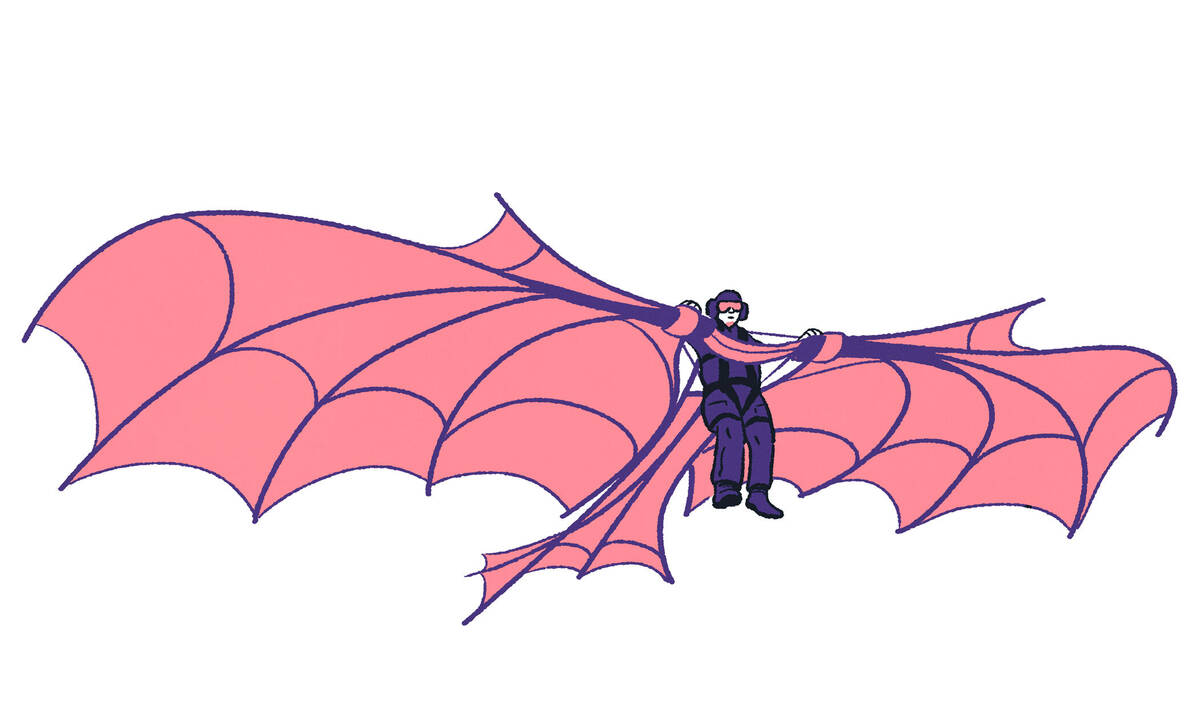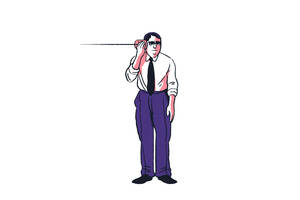Leadership Leadership Oct 13, 2025
Podcast: When We Get Too Comfortable, It’s Tough to Take Flight
On this episode of The Insightful Leader, an executive coach offers three tales of leaders who let complacency get in the way of success.

Michael Meier
Scary as it is, it’s important for leaders to try new—and unproven—things.
“Everyone falls. Great leaders get up and start running again,” says Sanjay Khosla, an executive coach and adjunct professor at Kellogg.
In this episode of The Insightful Leader: clinging to comfort yields diminishing returns. We hear how three leaders broke the habit.
Podcast Transcript
Laura PAVIN: You’re listening to The Insightful Leader. I’m Laura Pavin.
We want to see leaders in a certain light—as the people who have the wisdom and confidence to guide us in the right direction. It’s an expectation that, needless to say, makes leaders scared to do the “wrong thing.” To fail. And so, over time, they tend to just stick with a playbook of what’s worked before.
Sanjay KHOSLA: A CEO said to me, “this is the way we’ve always done things in this company.” And I was thinking, “my God, what a dangerous statement.”
PAVIN: Kellogg Professor Sanjay Khosla teaches executive education courses at Kellogg. He’s worked with hundreds of business leaders.
KHOSLA: I believe that you can learn much more from failure than success. Everyone falls. Great leaders get up and start running again. Or flying again. Others don’t.
PAVIN: Doing what’s comfortable can be riskier than actually taking a risk and failing. Today, we bring you three stories about leaders who opt for comfort—consequentially. We’ll hear about the leader who gives a toxic employee too many chances, a leadership team that opts to deliver high-stakes news via email, instead of face-to-face, and a company that becomes so internally-focused that it loses sight of the big picture.
Throughout, we learn a valuable lesson about leadership.
KHOSLA: All of us have a choice. We can either be cozy or we can fly.
PAVIN: Khosla shares his stories and insights, next. Stay with us.
…
PAVIN: In his long career working for major companies like Kraft and Unilever, Khosla has had to make countless high-stakes decisions. He says that, for the most part, it’s not the decisions that he regrets, it’s the timing of when he made them.
Like, there was this one situation with one of his employees. We’ll call him Dave. Dave was in many ways an all-star. Super bright. Articulate. Turned in good work. But the trouble was that everything was all about himself.
KHOSLA: It was very clear he was not a team player. He always started the meeting with a point of view, and the attitude was, “it’s either my way or the highway” sort of stuff.
PAVIN: He was opinionated and fancied himself superior to everyone around him. Took credit for things he wasn’t involved with. The team he ran didn’t love it.
Khosla saw this and thought that maybe Dave just needed a little coaching. So he told him, “hey, your results are great, but you need to work with your team more, okay?”
KHOSLA: But I think he was just too far gone.
PAVIN: The behavior continued. Dave’s team called him “toxic” in surveys. Khosla took that information in. And sat on it.
KHOSLA: I was just cozy and let things lie and let it go and, you know, “it’s okay,” and give him feedback.
PAVIN: To go on thinking that Dave could change, deep down, was a bit too wishful. Things didn’t get better. But Khosla kept giving Dave feedback, hoping he’d use it.
Eventually, the head of HR took Khosla aside and said, “Hey, you need to set the tone here. To keep Dave here would be against our values.”
Khosla listened.
KHOSLA: I actually called him on a Friday evening and said, I think you have to go. When he did leave, there was a tremendous change in energy. We were back to becoming a team. A collaborative organization.
PAVIN: It was difficult to let Dave go. But it led to a big “aha” moment for Khosla: That not making a decision is often a decision in and of itself. In this case, it was a bad one.
KHOSLA: You’re never quite sure what the right timing for these things is, but trying to make sure that we’re actually getting it roughly right in these decisions, rather than precisely wrong.
PAVIN: When you have a clear sense that something needs to change, don’t assume the situation will just resolve itself. Or as Khosla would say, stop being cozy.
…
PAVIN: But coziness doesn’t just show up in our decisions, it can also appear in the way we communicate.
Khosla remembers consulting with a large company that was going through a major acquisition. Overall, the transition had been going smoothly. Leadership at the company had put together a detailed email explaining the merger and the future strategy. They felt good about it and fired it off to 65,000 employees. They patted themselves on the back and moved on to the next task.
But a few months later, Khosla and his team started hearing feedback from the staff.
KHOSLA: After six months we did an anonymous survey, an engagement survey, and there was one thing that stood out which shocked everyone, and that was under the score of communication.
PAVIN: The score was super low. Khosla and executives at the company were stunned. They thought their email was crystal clear. They’d spent a ton of time making sure it was.
But reading through the responses, the executives realized that the email wasn’t the real issue.
The feedback that came from the survey was that, yes, corporate direction, vision, strategy—all that—was very, very clear. But there was no communication at the individual level, and there was so much uncertainty and anxiety because of the change.
People wanted to hear it straight from the horse’s mouth what this meant for them, personally. The problem, though, was that not even the executives fully knew. It was much easier for them to send a carefully crafted email than it was to say, “I don’t know.”
But it would have been better if they had. Artfully, of course.
KHOSLA: You could tell them that this is the timeline and this is our plan to get a plan, but we didn’t have all the answers. You had to be authentic.
PAVIN: Eventually, with Khosla’s help, the company organized sessions where small groups of employees could ask questions and hear what managers knew and didn’t know. And they created clear timelines for when they’d have more information to share.
These can be emotional conversations. But Khosla says that if you’re authentic, it’s going to be far better for you and your employees. So, even if it makes you want to squirm, you can’t let coziness stop you from having those tough talks.
…
PAVIN: In Khosla’s work with executives and companies, he’s noticed a common location where dangerous coziness thrives: the meeting room. For obvious reasons, leaders like to gather their teams and get everyone on the same page. But left unchecked and unsteered, these meetings can become repetitive time-wasters.
Khosla remembers this one time. He’d just started doing some consulting work for a global technology company.
KHOSLA: The first thing that struck me in this company is how many meetings they had. Everyone was in back-to-back meetings. It was a frenetic pace. Half these people actually didn’t need to be in the meetings.
PAVIN: A lot of the meetings were about internal policies and procedures. Or business review meetings that looked at the past instead of the future.
Also, presenters were just kind of reading their slides aloud instead of openly discussing solutions. You know the kind of meetings we’re talking about.
KHOSLA: This is happening today in so many successful companies: murder by PowerPoint.
PAVIN: Employees said as much to Khosla. They were getting totally pummeled by these kinds of meetings. Meetings that were focused on what felt like the wrong things.
KHOSLA: Essentially, what people were saying is that we are spending so much time looking at the mirror, at ourselves, and internally pleasing the leaders.
PAVIN: This inward focus was distracting the company from its main purpose: growing its customers.
Khosla sees this focus as a form of coziness, too. Once your company becomes successful, it’s easy to take your customer base for granted. You assume you’ve got customers figured out and instead become obsessed with the internal workings of the company.
For an executive, of course, hearing about all the little ways your company is becoming more efficient is a comfortable place to be. But according to Khosla, it’s also a great way to make your company stagnant.
KHOSLA: They were market leaders and now they’re struggling.
PAVIN: With the CEO, Khosla started shifting the culture of the company. Employees started spending more time outside the office collecting customer feedback and insights that informed company strategy—and less time on meetings to satisfy internal stakeholders.
KHOSLA: We’ve now slashed the meetings in half, but it had to start at the top. It’s been a difficult transition for the entire organization, particularly the leader and leadership, to go from looking more outside the window than in the mirror. So it’s not easy.
PAVIN: And those business review meetings? They’re now business outlook meetings, focused on planning for the future instead of rehashing the past. Khosla says this forward-looking agenda inspires people to get out of their routines and start getting creative.
KHOSLA: Seventy percent of the time, the energy in the meeting is spent on the future, thirty percent on the past—which is a complete reversal of what has happened, since you’re asking for points of view from different people in the meeting on how can we scale what’s working, and how do we fix what’s broken. We’re actually getting people with the nurturing questions to speak their mind. And the type of suggestions that are coming in are in the realm of flying, not being cozy.
PAVIN: By pressing pause and zooming out, the company was able to ask itself a very important question: Is the work we’re doing really serving our company’s purpose? Or are we just making ourselves happy? Doing what makes you feel good may be nice, but it’s not going to help your company or organization thrive.
KHOSLA: This is not business as usual. No, it isn’t. It’s actually dramatically changing how people work and it’s worked reasonably well.
PAVIN: It’s natural human behavior to go with what’s worked in the past instead of trying something new and risky. Khosla isn’t asking people to fight that instinct but to reflect on whether habit or fear is making you choose the easy path. Sometimes, just taking a step back can help you avoid this common cause of failure.
…
PAVIN: So, to recap: We’ve got to trust our gut when we sense that change, even difficult change, is necessary. We need to make ourselves vulnerable to tough conversations and be honest when we don’t know something. And sometimes we have to look out the window and focus on what matters to the business instead of making us happy with the latest update. So when you find yourself confronting one of these challenges, Khosla has this message for you.
KHOSLA: You have a choice, whether to be cozy or fly. It’s very, very, very dangerous to be cozy. You have to fly.
[CREDITS]
PAVIN: This episode of The Insightful Leader was written by Andrew Meriwether. It was produced and edited by Rob Mitchum, Laura Pavin, Fred Schmalz, Maja Kos, and Blake Goble. It was mixed by Andrew Meriwether. Special thanks to Sanjay Khosla. Want more The Insightful Leader episodes? You can find us on iTunes, Spotify, or our website, insight.kellogg.northwestern.edu.
We’ll be back in a couple weeks with another episode of The Insightful Leader podcast.


